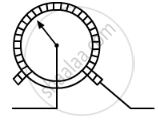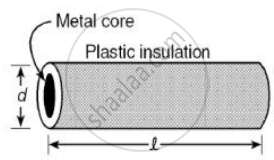Advertisements
Advertisements
प्रश्न
What do you understand by the "resistivity" of a substance?
उत्तर
We know that resistance , `R=(rhol)/A`
So resistivity, `rho=RA/l/`
When the area of cross-section, A is 1 m2 and the length of the wire, l is 1 m, resistance is equal to resistivity.
Resistivity may be defined as the resistance offered by a conductor of length 1 m and area of cross-section 1 m2.
APPEARS IN
संबंधित प्रश्न
Two conducting wires of the same material and of equal lengths and equal diameters are first connected in series and then parallel in a circuit across the same potential difference. The ratio of heat produced in series and parallel combinations would be:
A copper wire has diameter 0.5 mm and resistivity of 1.6 × 10−8Ω m. What will be the length of this wire to make its resistance 10 Ω? How much does the resistance change if the diameter is doubled?
List the factors on which the resistance of a conductor in the shape of a wire depends.
Why are alloys commonly used in electrical heating devices? Give reason.
What will be the resistance of a metal wire of length 2 metres and area of cross-section 1.55 × 10−6 m2 if the resistivity of the metal be 2.8 × 10−8 Ω m?
What would be the effect on the resistance of a metal wire of:
increasing its length?
The figure blow shows a variable resistor in a dimmer switch.

How would you turn the switch to make the lights: (a) brighter, and (b) dimmer? Explain your answer.
How will you infer with the help of an experiment that the same current flows through every part of the circuit containing three resistors R1, R2 and R3 in series connected to a battery of V volts?
How will you infer with the help of an experiment that the same current flows through every part of the circuit containing three resistances in series connected to a battery?

Plastic insulation surrounds a wire having diameter d and length l as shown above. A decrease in the resistance of the wire would be produced by an increase in the ______.
